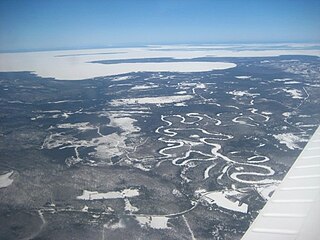
Cobalt is a town in Timiskaming District, Ontario, Canada. It had a population of 1,118 at the 2016 Census.

Walden was a town in the Canadian province of Ontario, which existed from 1973 to 2000. Created as part of the Regional Municipality of Sudbury when regional government was introduced, the town was dissolved when the city of Greater Sudbury was incorporated on January 1, 2001. The name Walden continues to be informally used to designate the area.

Nickel Centre was a town in Ontario, Canada, which existed from 1973 to 2000.

Swansea is a Ghost town in La Paz County in the U.S. state of Arizona. It was settled circa 1909 in what was then the Arizona Territory. It served as a mining town as well as a location for processing and smelting the copper ore taken from the nearby mines.

Gilman is an abandoned mining town in southeastern Eagle County, Colorado, United States. The U.S. Post Office at Minturn now serves Gilman postal addresses.

Unorganized North Algoma District is an unorganized area in northeastern Ontario, Canada, comprising all areas in Algoma District, north of the Sault Ste. Marie to Elliot Lake corridor, which are not part of an incorporated municipality or a First Nation. It covers 44,077.03 km2 (17,018.24 sq mi) of land, and had a population of 5739 in 2016.

The Huron Central Railway is a railway operating in northern Ontario, Canada. It is operated by Genesee & Wyoming Canada, the Canadian subsidiary of Genesee & Wyoming.

The North Shore is a township in the Canadian province of Ontario, located in the Algoma District. The township had a population of 497 in the Canada 2016 Census. It is along the north shore of the North Channel of Lake Huron, with its main communities all along Highway 17.

Picacho is an unincorporated community in Imperial County, California. It is located on the Colorado River 29 miles (47 km) south-southeast of Palo Verde, at an elevation of 203 feet.

Jerome Mine is an unincorporated area and ghost town in the Unorganized North Part of Sudbury District in northeastern Ontario, Canada. It was a short-lived mining community and is located on Lake Opeepeesway.

Kimberly is a ghost town in the northwest corner of Piute County, Utah, United States. Located high in Mill Canyon on the side of Gold Mountain in the Tushar Mountains, Kimberly was formerly a gold mining town. Originally settled in the 1890s, it lasted until 1910. Kimberly had a minor rebirth in the 1930s, but has been uninhabited since approximately 1938. The town is perhaps best known as the birthplace of Ivy Baker Priest, a former United States Treasurer.

The city of Timmins, Ontario, Canada contains many named neighbourhoods. Some former municipalities that were merged into Timmins continue to be treated as distinct postal and telephone exchanges from the city core.
Tertiary Highway 802, commonly referred to as Highway 802, is a provincially maintained tertiary road in the Canadian province of Ontario, located in Thunder Bay District. The 13.7-kilometre (8.5 mi) route branches both north and south from Highway 11 to connect with the ghost town of Burchell Lake and the community of Kashabowie, respectively. The highway was established in 1962 at the peak of operations of the Burchell Lake mine. Although the mine and town were subsequently abandoned in 1966, the highway remains under provincial jurisdiction. The section that travels concurrently with Highway 11 forms part of the Trans-Canada Highway.
The Cobalt silver rush started in 1903 when huge veins of silver were discovered by workers on the Temiskaming and Northern Ontario Railway (T&NO) near the Mile 103 post. By 1905 a full-scale silver rush was underway, and the town of Cobalt, Ontario sprang up to serve as its hub. By 1908 Cobalt produced 9% of the world's silver, and in 1911 produced 31,507,791 ounces of silver. However, the good ore ran out fairly rapidly, and most of the mines were closed by the 1930s. There were several small revivals over the years, notably in World War II and again in the 1950s, but both petered out and today there is no active mining in the area. In total, the Cobalt area mines produced 460 million ounces of silver.

The Milliken Mine is an abandoned uranium mine located approximately 2.5 km northeast of Elliot Lake, Ontario, owned and operated by Rio Algom Ltd. The site has been rehabilitated and its tailings facility is currently undergoing environmental monitoring by Denison Environmental Services as part of the monitoring of the Stanleigh Mine and tailings facility.

Kimberly is a ghost town in the state of Nevada. A mining town situated west of Riepetown and east of the former town of Veteran, Kimberly once boasted over 500 inhabitants.

A Yellowcake boomtown is a town or community that rapidly increases in population and economics due to the discovery of uranium ore-bearing minerals, and the development of uranium mining, milling or enrichment activities. After these activities cease, the town "goes bust" and the population decreases rapidly.

Coldstream Copper Mine, sometimes called the North Coldstream Copper Mine, or the Coldstream Mine, or North Coldstream Mine is a decommissioned former copper, silver and gold mine adjacent to Burchell Lake, Ontario 11km south of Kashabowie, in Northern Ontario, Canada.















